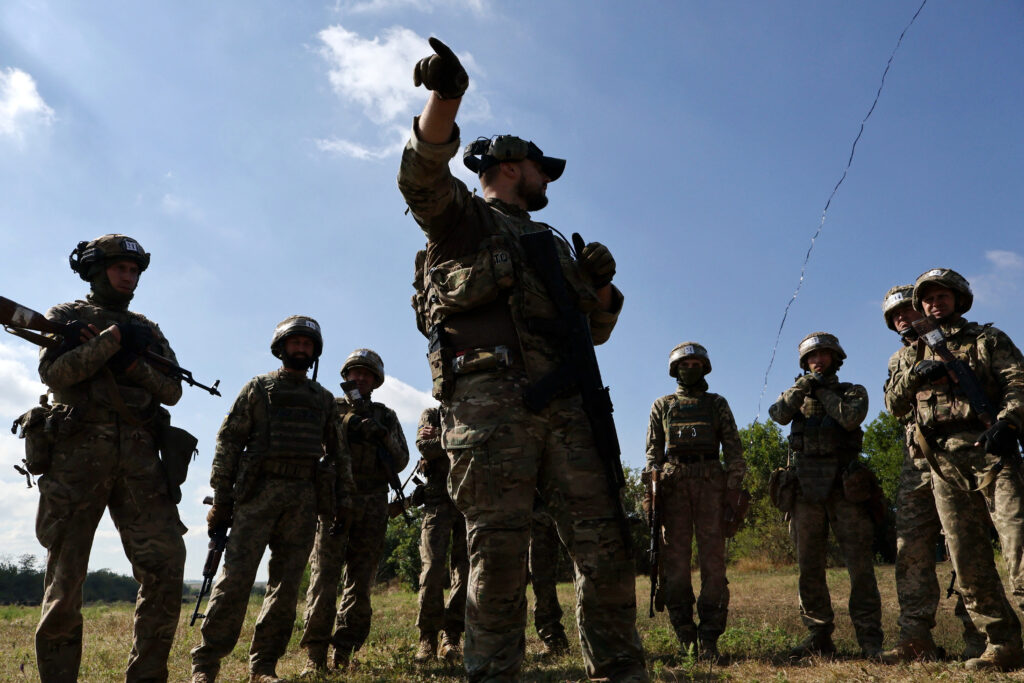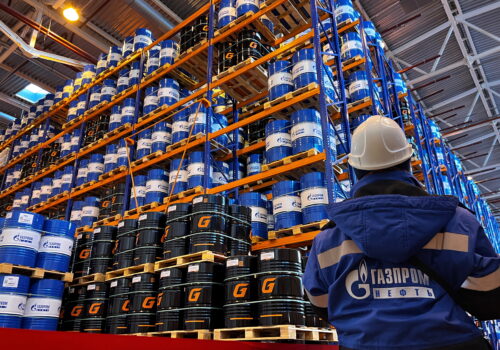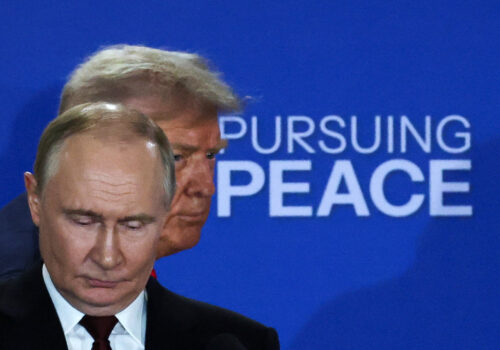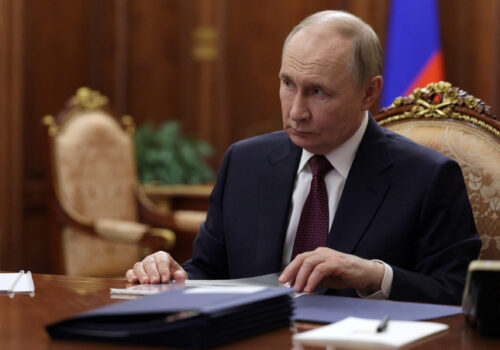It’s not enough to stop a war; it must then stay finished.
Among the most critical but least developed elements of a potential arrangement to end Russian President Vladimir Putin’s invasion of Ukraine is the security guarantee that Kyiv will need to deter another attack from Moscow. That will require a deterrent force with substantial presence in Ukraine, including forces from the United States. Deterring future Russian military aggression is an achievable but nonetheless challenging and grave undertaking for the transatlantic community—one that is the subject of ongoing discussions among transatlantic officials following the recent White House leaders’ summit.
Before digging into the specifics of what a US-backed deterrent should look like, it’s worth exploring the four most prominent difficulties a deterrent force will need to address.
- A determined adversary. A deterrent force must address a Russian adversary that, even after signing a peace agreement, will remain determined to suborn Ukraine and to weaken, if not eliminate, NATO. It would be naïve to assume that Putin will ever shelve those objectives. He has repeatedly violated international agreements before, including the Minsk agreements signed with the aim of ending the war Putin first launched against Ukraine in 2014. He will not hesitate to disregard another armistice and attack Ukraine again if he concludes that an opportunity has emerged to advance his hegemonic ambitions.
- A massive Russian force. The Western deterrent force and Ukrainian troops will be tasked with staving off an attack from a substantial Russian adversary. Russia’s economy ($2.1 trillion in 2024) is ten times the size of Ukraine’s ($190 billion), its population (143 million) is nearly four times larger, and its leader is willing to sacrifice hundreds of thousands more Russians to achieve his war aims. Some 600,000 to 700,000 Russian troops are occupying Ukrainian territory. They are being reinforced with additional personnel and by a war economy that is increasing the production of everything from ammunition and tanks to drones and hypersonic missiles. And Russia currently has the upper hand as it grinds down Ukraine’s armed forces, destroys its national infrastructure, and slowly but steadily seizes more Ukrainian territory.
- Difficult geography. The magnitude of the geography defining this conflict presents a third challenge. The deterrent force will need to help Ukraine defend a military frontier that includes nearly the entire length of Ukraine’s one-thousand-kilometer-long border with Russia’s closest ally, Belarus. This force must also help Ukraine defend an internal line of confrontation spanning 1,200 kilometers, stretching across the regions of Kharkiv, Luhansk, Donetsk, and Kherson. On top of this, Ukraine and its partners will need to deter and defend against attacks from the Black Sea and via long-range air, drone, and missile strikes.
- The need for transatlantic determination. Deterrence only works if an adversary believes one has the necessary capability, intent, and determination—in other words, the will to fight. When Putin considers the correlation of forces before him in Ukraine, nothing shapes his perception more than the posture of the United States.
Putin knows that Washington and its allies have more than enough capacity to reverse his gains in Ukraine, but it is nearly certain that he doubts the United States has the will to do so. Three US administrations over the past eleven years—from when Russia launched it war against Ukraine in 2014—have repeatedly asserted that there would be “no US boots on the ground” to defend Ukraine. The Obama, Biden, and first Trump administrations all asserted that such intervention was not worth risking a nuclear conflict. This was among the key reasons that Washington slow-rolled shipments of tanks and aircraft to Kyiv and limited the ranges of long-range strike capabilities it sent to Ukraine.
Moreover, the second Trump administration has repeatedly signaled that the United States has no vital interests at stake in this war. In its view, this war is a European concern, not a US one. US President Donald Trump has said of Russia’s invasion of Ukraine that “this is not my war,” largely limiting his interest in the conflict to the humanitarian goal of “stopping the killing” of Russians and Ukrainians. And twice in the past three months, Trump has balked on his threats to impose “massive” economic sanctions on Russia for refusing to initiate a cease-fire—sanctions that would, of course, risk triggering blowback on the US economy.
What a deterrent force in Ukraine will need
Under these conditions, a deterrent force will need to be robust, with significant elements deployed in Ukraine. Combined with Ukraine’s forces, it will need to present the necessary offensive capacity to jeopardize the illegitimate territorial gains that Putin has achieved in this war. That will require not just air and missile defenses, but also the firepower necessary to punch a hole through Russian lines and enable Ukraine to retake lost territory if Russia were to renew hostilities. Simply put, Putin will only be deterred if he believes that further aggression will jeopardize his gains.
The deterrent force must include a US military presence in Ukraine—though this doesn’t necessarily have to mean “boots on the front lines.” The presence of Americans is the only way to convince Putin that the nations comprising the deterrent force will respond forcefully and decisively if he violates an armistice. Europe must provide the bulk of the ground forces and perhaps all of those that are most forward deployed. But the US contribution should, at a minimum, include in-country air defense, long-range fires, special forces, command-and-control capabilities, and intelligence. The United States should also commit air forces whose missions would include close air support to strike Russian forces if necessary.
That combination of an integrated US strike capability and in-country presence is essential. Without it, Russia will be tempted to try to break transatlantic unity and resolve by striking European elements. Such an attack would test the United States’ will to back up its European allies and partners. Without a US presence in Ukraine, European forces will be missile magnets in the Kremlin’s war against Ukraine and its attack on NATO unity, as Putin could conclude that the United States will once again fail to deliver on its threats against Moscow. Nothing would be more pleasing for Putin than a shattering of the transatlantic alliance, which would leave all of Central and Eastern Europe vulnerable to his hegemonic ambitions.
To effectively deter further Russian attacks on Ukraine, Kyiv’s allies and partners must also provide equipment and training to Ukraine’s armed forces, assist Ukraine’s economic reconstruction and recovery, and refuse to recognize Russian sovereignty over illegally seized Ukrainian territory. Such recognition would only reward aggression and encourage its return.
As Putin continues to balk on a cease-fire, clearly intending to prolong his efforts to kill more Ukrainians, destroy more Ukrainian infrastructure, and seize more territory, now is the time to impose truly punishing economic sanctions on Russia. That will not only provide a long-overdue increase in pressure on the Kremlin to accept a cease-fire, but it will also help demonstrate that the United States has the determination to oppose Russia’s aggression. Such economic measures will also add needed credibility to the transatlantic deterrent posture in Ukraine.
Deterring Russian aggression is a challenging mission for the transatlantic community, but one that can be decisively accomplished. NATO members have a combined gross domestic product (GDP) more that twenty-five times that of Russia. The Alliance outspends Russia on defense by a factor of nearly ten, and NATO is on track to widen that gap as more allies fulfill their pledge to increase their defense budgets to 5 percent of GDP. NATO does not lack for resources and military might. What has been lacking is the political will and courage to leverage this overmatch in power to stop Russia’s aggression against Ukraine.
Ian Brzezinski is a resident senior fellow with the Scowcroft Center for Strategy and Security and former US deputy secretary of defense for Europe and NATO policy.
Further reading
Tue, Aug 26, 2025
To end Putin’s war on Ukraine, Trump should sanction Russian oil
New Atlanticist By Kimberly Donovan
The US president is well positioned to bring about peace for Ukraine, but his administration needs to arm him with the best tools and options to do so.
Thu, Aug 21, 2025
Sorry, Trump, but Putin will not pursue peace until he is facing military defeat
UkraineAlert By
Following the recent Alaska and White House summits, it should now be abundantly clear that Russia will continue to reject Trump’s peace overtures until Putin faces significantly more pressure to end the war, write Elena Davlikanova and Yevhen Malik.
Mon, Aug 25, 2025
Putin’s hybrid war against Europe continues to escalate
UkraineAlert By
While international attention focuses on faltering US-led efforts to broker a peace deal and end the Russian invasion of Ukraine, the Kremlin’s broader hybrid war against Europe continues to escalate, writes Maksym Beznosiuk.
Image: Recruits of the 65th Separate Mechanized Brigade of the Ukrainian Armed Forces attend a military drill near a frontline, amid Russia's attack on Ukraine, in Zaporizhzhia region, Ukraine August 25, 2025. Andriy Andriyenko/Press Service of the 65th Separate Mechanized Brigade of the Ukrainian Armed Forces/Handout via Reuters.




